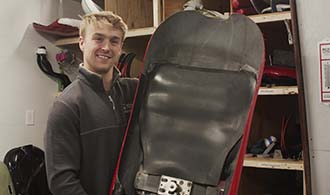
Published
by Rogers Corporation
Elastomeric Material Solutions
A few years ago, a Rogers Research and Development team in Connecticut received an inquiry from an unusual source — a coach in search of new materials to benefit world-class U.S. athletes training in competitive luge.
The team needed new padding for its sleds. The generic, department-store foam being used to line the sleds wasn’t cutting it, and the team hoped Rogers had a specialized material in its portfolio to help optimize athletes’ performance on the track.
USA Luge first heard of Rogers in 2019 from one of its partners, a materials company that works with Rogers as a supplier. After receiving the team’s initial request, Research and Development Manager for PORON® Joseph Puglisi launched a full research evaluation to help outfit the team.
“They sent us samples of what they were currently using — some of which were as simple as cut up yoga mats,” Puglisi said. “We took their used padding to the lab and analyzed the properties, and from there we matched the team with some of our existing products.”
Puglisi said the Rogers team had fun helping the lugers find the best materials.
“We took bunch of samples of our materials and compared them against the athletes’ needs for vibration isolation, comfort, support, temperature range, size and thickness.” Puglisi said. “We compared what we had to what they sent us. We even got on the floor and laid on the pads to imagine what they would be feeling in their sleds.”
After the extensive analysis, the inquiry eventually found Principal Technical Service Engineer Daniel Kubick, who introduced the lugers to the temperature-resistant cushioning properties of BISCO® Silicone Foams.
“When we got the request, we worked with the USA team to learn about their needs and educate them on the beneficial properties of each product,” Kubick said. “We ended up sending them samples of BISCO, which are on the lower end of the compression force deflection range. They are soft enough to provide a dampening effect on the track while holding structure.”
A key benefit of BISCO foams is their ability to maintain their properties in temperature extremes, a key for athletes practicing in a range of temperatures – ranging anywhere from room temperature to temps well below zero. BISCO foams are available with a pressure-sensitive adhesive, which also offered a better solution for applying pads to sleds.
Mark Grimette, Sport Program Director for USA Luge, said the team historically used regular foams adhered with duct tape for the bottom of the sled. They weren’t efficient in supporting the physics of the athletes.
“An athlete going down the track can experience four or five g-force while taking a run,” Grimette said. “Anything we can do inside the sled to help kind of dampen those forces is key to the performance in making a faster sled. Rogers Corporation was very helpful in finding a better padding for our athletes.”
Robert Fegg, the National Head Coach for USA Luge, said although they appear simple from the outside, the sleds used in luge are carefully crafted, high-tech machines.
“Our sport is decided by one-thousandths of a second,” Fegg said. “If I can find extra thousandths of a second, that can decide a race. If I know I have the right material, I don’t think about it, and I can focus on what’s important.”
The partnership between Rogers Corporation the USA Luge team continued into the 2022 Winter Games in Beijing, where two athletes competed for the world’s top positions with the help of BISCO in their sleds.
To show its support of the team, Rogers offered the athletes free materials and education on the performance benefits for different BISCO products. Senior Product Manager Nadine Dytko-Madsen said Rogers’ superior knowledge of materials science made it possible to find the right products for the athletes’ preferences. Rogers worked with USA Luge to find a material that balanced density and thickness and still maintained weight requirements for the sleds.
“We are proud to have led them to something they didn’t even know existed that could help them in a significant way,” Dytko-Madsen said.
Tucker West, an Olympian who represented USA Luge in Beijing, uses BISCO BF-1000 Extra Soft Cellular Silicone in his sled.
“The BISCO material is steps ahead of other materials that we’ve tried before,” West said. “The forces that we experience down the track can exert a lot of wear and tear on our bodies. The BISCO pad’s shock absorbance helps reduce some of that wear and tear.”
Emily Sweeney took her sled lined with BISCO HT-870 Soft Silicone Foam to the Winter Games. Her slightly denser pad allows her to feel important vibrations on the track while dampening what isn’t critical to the race.
“I love the way this felt in my sled,” Sweeney said. “It is more dampening that what we were previously using, which allows for speed and minimizes some of the vibrations.”
Rogers was proud to support the USA Luge team in Beijing and provide members with materials to help them succeed. According to Kubick, the ongoing partnership has challenged Rogers to think bigger and imagine new applications for the BISCO product line.
“BISCO is primarily used in gasketing and sealing applications,” Kubick said. “Not only was it really fantastic to solve a problem for the USA Luge team, it has also challenged us to consider that there are endless possibilities out there for Rogers materials.”
Related Products:
BISCO Silicones
Published on Feb 25, 2022
